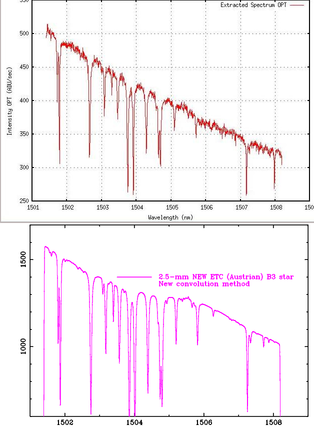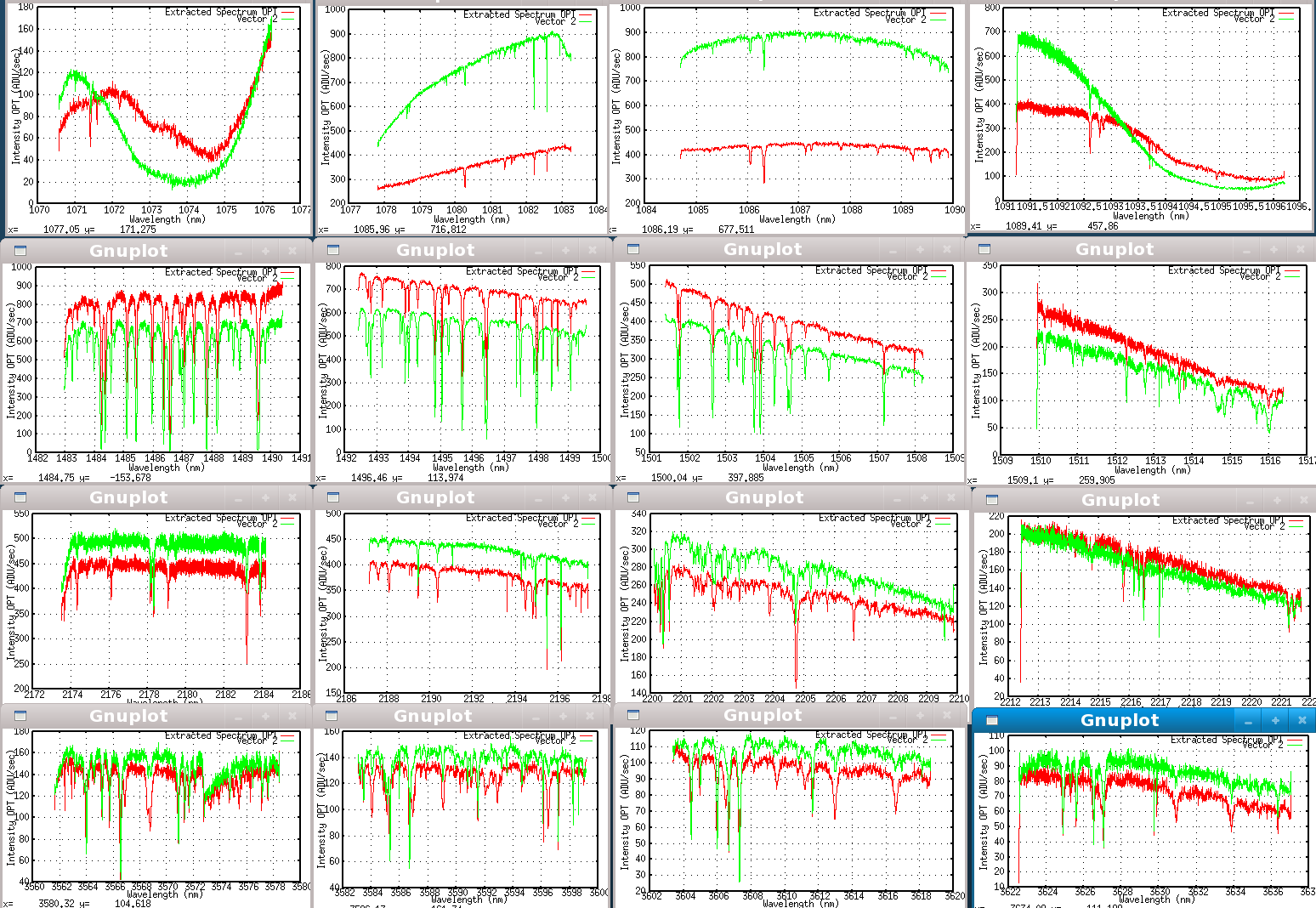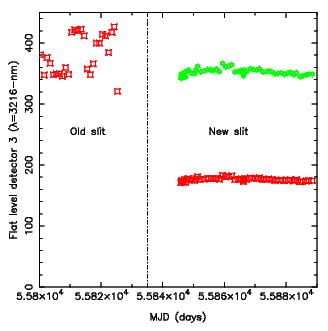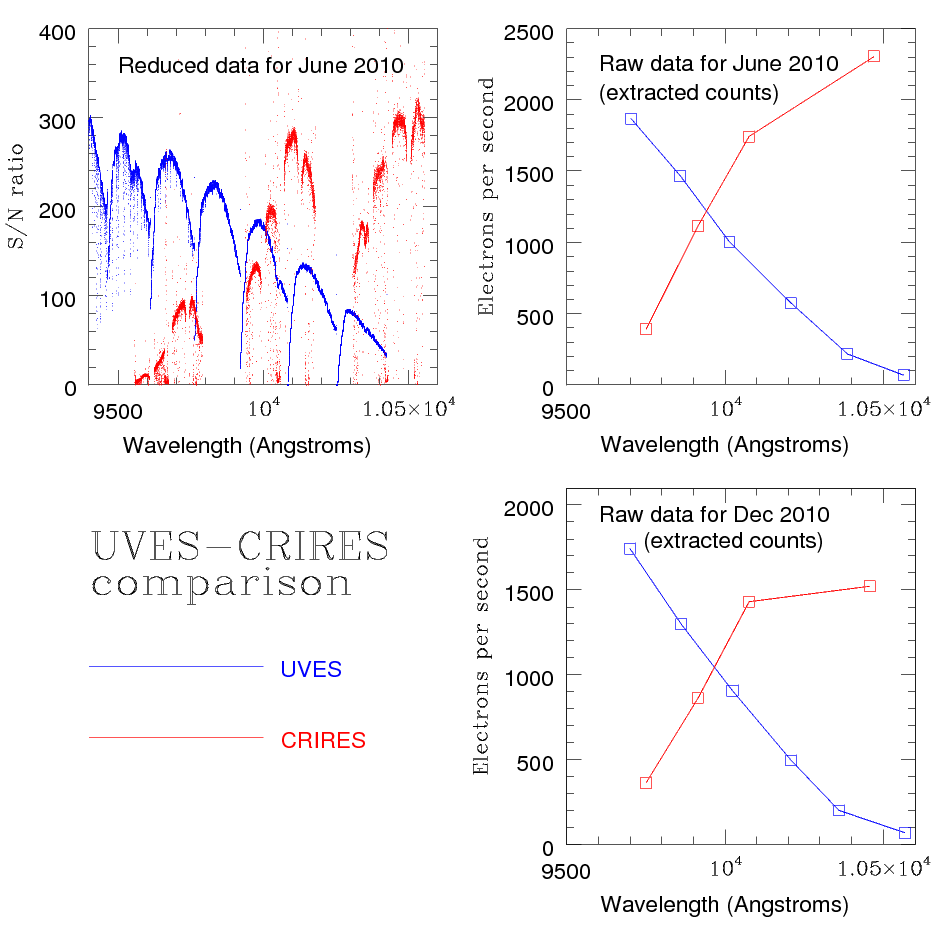Original CRIRES News
On this page, we list the main changes that affected the original CRIRES (pre-upgrade).
- Jan 20th 2020: The comissioning of the warm part (adaptive optics) of CRIRES is ongoing on UT3. Comissioning will continue in Period 104 and 105 with the instrument offered to the community likely in P107. Science verification is planned for the middle of 2020 with a call for proposals being released after the first full-instrument comissioning. Details to be released on this news page and via the ESO Science newsletter.
- Aug 14th 2019: The latest news is that CRIRES plus will be comissioned on the UT3 Nasmyth B focus in Period 104 and 105 and offered to the community from October 2020. More news once the comissioning starts.
- Nov 26th 2018: The latest news is that CRIRES will be comissioned on the UT3 Nasmyth B focus in Period 103. More news when available.
- Mar 13th 2018. The latest news is that CRIRES plus will will be installed and commissioned on the UT3 Nasmyth B focus in Period 102 and Period 103.
Depending on the results of the commissioning, CRIRES will be offered in Period 104 (i.e. from 1st October 2019).
- Oct 1st 2015. The latest news from the CRIRES plus team states that first light of CRIRES plus will be in Q2 of 2018 with community access expected shortly after. The CRIREs plus website is available here.
- Sept 23rd 2015: The ESO Call For Proposals for P97 states that: "CRIRES was taken out of operations in July 2014 to undergo a major upgrade that will transform it into a cross-dispersed echelle spectrograph. It is therefore not offered in Period 97. Operations will likely not start before the end of 2017."
- Sept 2nd 2014: The last night of CRIRES was 16th July 2014 after which the instrument was removed from UT1 for an upgrade which is described in the ESO Messenger article http://www.eso.org/public/announcements/ann14053/
- Dec 22nd 2013: CRIRES will be unavailable for an extended period of time, with the last night of operations expected to take place on July 16th 2014. CRIRES will be shipped back to Garching and handed over to the CRIRES plus upgrade project. See http://www.eso.org/public/science/announcements/sciann13065/ for details.
- Sep 25th 2013: An extra setting for CRIRES will be offered in visitor mode in P93. The wavelength range up to 5384.1-nm will be covered using order 11. The throughput at 5300.0-nm is at worst 70 percent of that at 5219.1-nm. To check the atmospheric transmission at this wavelength one should use the skycat tool. Any questions please contact usd-help@eso.org.
- Sep 17th 2013: The tools page was changed to fix a problem with the script that produces the paf files needed when using differential tracking.
- Aug 29th 2013: CRIRES user manual P93.1 and data reduction cookbook P93.1 released; see the manuals page.
- Jun 29th 2013: CRIRES user manual P92.2 released; see the Manuals page.
- May 18th 2013: On 8th May 2013 the ThAr lamp failed. This is used for wavelength calibration for settings of less than 2.4 microns. The new lamp has fewer lines hence the quality of the wavelength solution is diminished. User Support Division have got in touch with Service Mode users to advise them of the situation. A page comparing old and new lamp has been made available here at DFO
- Feb 28th 2013: CRIRES user manual P92.1 released; see the Manuals page.
- Dec 21st 2012: CRIRES user manual P91.2 released; see the Manuals page.
- Nov 22nd 2012: Remember that the CRIRES pipeline has recently be updated with improvements to wavelength calibration amongst other enhancements. In common with other Paranal instruments, visiting astronomers are no longer provided with DVDs at the end of their run and should download their data using the archive and using the "calSelector" option to obtain calibrations closest in time to their observations.
- Nov 05th 2012: CRIRES data reduction cookbook released; see the Manuals page.
- Sep 21st 2012: CRIRES ETC updated Sept 20th 2012 to fix problem with background flux calculation at airmass not equal to 1.0..
- Sep 18th 2012: Bug in the CRIRES ETC discovered in calculation of background flux for airmass not equal to 1.0. ETC will soon be updated.
- Aug 28th 2012: User manual for P91 Phase1 released.
- Jun 28th 2012: User manual for P90 Phase 2 released. OBs should be prepared in P2PP3 which support concatenations of OBs or OBs with time links. Water vapour now a constraint for CRIRES observations from P90. Slit viewer zero points determined and Exposure Time Calculator now uses the Austrian model. See the User Manual for details.


- Jun 13th 2012: CRIRES back in operations.
- May 28th 2012: CRIRES out of service as UT1 main mirror is being recoated. News when back in operations.
- May 26th 2012: From P90 attached calibrations will be possible with a 0.2 or 0.4 arcsecond slit. Time links and containers will also be available within p2pp3, for example for science-telluric observations. Characterisation of the CRIRES slit viewer is ongoing and results will be presented in the P90 manual.
- Feb 26th 2012: CRIRES user manual for phase I period 90 updated. Main changes are (1) PWV will be a constraint from P90; the ETC has been updated accordingly and it is planned to include the value of PWV in the FITS header. (2) From P89 no PI packs for service mode observations have been distributed. PIs should use the ESO archive to download their data and use calSelector to obtain the correct calibrations for reduction purposes. (3) From P90 the calibration frequency may be reduced and (4) From P90 it will be possible to set the slit width for the night-time calibrations to 0.2 or 0.4 arcseconds.
- Feb 25th 2012: Spectrophotometric standard Eta Hy before (red) and after (green) the slit intervention in September 2011. Detectors 1,2,3 and 4 are shown. At the very bluest settings detectors 1 and 4 are not useable although in any case they suffered from order contamination in pre-September 2011 observations. Reference wavelengths from top to bottom are 1087, 1504, 2205 and 3611-nm.

- Dec 23rd 2011: CRIRES user manual for Phase 2 period 89 updated.
- Nov 22nd 2011: Flatfield levels before and after the replacement of the slit. The levels are now much more stable that may indicate some reduction in the frequency of calibrations in the future. The red points are the raw data, the green points are scaled points:

- Oct 14 2011: CRIRES back in operations with two fixed slits at 0.2 and 0.4 arcseconds width, plus a closed position. There are three issues still under investigation related to (1) The focus of the system on the slit viewer camera vs the spatial direction on the science detector (2) Relative flux levels in flatfields at 0.2 and 0.4 slit widths (3) Comparison of standard star data pre- and post- intervention. More details to be added here. User manual will be updated before phase 2 when the web-pages will also be changed.
- Sep 21 2011: CRIRES intervention started to replace the entrance slit unit with one with fixed slit widths 0.2 and 0.4 arcseconds only, plus perform maintenance tasks including closed cycle cooler replacement.
- Sep 05 2011: CRIRES user manual was released on Sept 5th for P89 phase 1. Note that an update to this document will be performed at the start of October 2011 after the move to fixed slits of 0.2 and 0.4 arcseconds.
- Jun 22 2011: CRIRES user manual was released on June 20th 2011 for P88 phase 2.
- Jun 22 2011: It is likely that with the change to fixed slitsof 0.2 and 0.4 arcseconds and the introduction of metrology in P88 thatthe repeatability and accuracy of flatfields and wavelengthcalibrations will improve. To reduce the calibration load then thevalidity of calibrations may be increased from 1 day starting in P89.
- Jun 21 2011: The CRIRES ETC has been changed to (1) Decreasethe predicted S/N ratio by a factor 1.3 for wavelengths beneath 1.1microns (2) Only allow seeing of less than 1.4 arcseconds for AO OBs.
- Jun 01 2011: The CRIRES ETC will be soon changed to (1) Decreasethe predicted S/N ratio by a factor 1.3 for wavelengths beneath 1.1microns (2) Issue a warning that for AO the calculated throughput isobtained using a seeing of 1.4 arcseconds.
- Jun 01 2011: The assumed overheads for Generic offset mode were in error. An overhead of 12 seconds per offset is now assumed.
- Jun 01 2011: The new instrument package for CRIRES (for P88)will only allow slit widths of 0.0 (closed slit, not used at themoment), 0.2 and 0.4 arcseconds.
- May 05 2011: Investigation into ETC througput in the J-band onging.
- Apr 14 2011. Dark levels for 300-s DIT darks now back to normal:

- Apr 11 2011. New version of CRIRES user manual released. Only the front cover names have changed.
- Mar 27 2011. Detector 4 is showing some features in the 300-s darks on the right hand side of the detector, and the readout noise has increased for detectors 3 and 4. Under investigation.See here for an example of detector 4 300-s dark taken on March 25th 2011.
- Mar 20 2011 UTC Time: 17:11:59 there was an earthquake that shifted the prism, hence moving the wavlength zero-point for some ofthe calibrations. The situation was recovered on March 21st and noscience data were affected.
- Mar 08 to 16th 2011. An intervention on CRIRES was performedon one of the closed cycle coolers. CRIRES back in operations on March16th.
- Mar 01, 2011. CRIRES user manual for P88 phase 1 released.
- Feb 18, 2011. An intervention is planned in early March 2011 for maintenance of the closed cycle coolers.
- Feb 18, 2011. A SLIT UPGRADE of CRIRES is planned at the start of P88. We hope to move to Two fixed slits of 0.2 and 0.4 arcsecond widths. The idea is to eliminate variations of up to 30 percent in the slit width reproducability.
- Feb 18, 2011. A comparison of standard stars with UVES/CRIRES has been performed. Since the UVES MIT CCD upgrade was undertaken, UVES is more sensitive in the Red. The crossover point is now ataround 1 micron (CRIRES more sensitive beyond that). More details will be available in the P88 user manual.

- Dec 25, 2010. Update to CRIRES user manual for phase 2.
- Nov 27, 2010. CRIRES back in operations.
- Nov 26, 2010. The warm part of CRIRES had to be dismounted onNov 13 due to M1 and M3 recoating. The instrument should be back soon.
- Sept 07, 2010. CRIRES is back in operations. The X-position of the slit on the slit viewer detector has changed from 532 to 568 pixels that means that the field of view to the right of the slit has decreased by about 2 arcseconds. The allowed delta X range is now -17.5"and 16.5". The slit is parallel to 0.02 arcseconds for a 10 arcsecond throw and 0.04 arcseconds for a 20 arcsecond throw. User manual updatedon 16-Sept-2010 to reflect the changes above.
- Aug 22, 2010. CRIRES is out of service starting August 22ndwhilst it undergoes another intervention. News will be posted when the instrument is available again.
- Aug 21, 2010. Problems with service mode CRIRES data are noted in the CRIRES SM pages.
- Jul 16, 2010. After the current intervention there is a problem with the alignment of the entrance and intermediate slit. Thismeans that likely only data from detector 2 and 3 will be useable. Under investigation but likely that another intervention will berequired in early August. The slit is now parallel to better than 10 percent over a throw of 20 arcseconds. The flatfields no longer show gradients in the cross dispersion.
- Jul 14, 2010: Another intervention on CRIRES is in progress. News to be posted soon.
- May 29, 2010: CRIRES is back in operations but with PROBLEMS.In particular the entrance slit is no longer parallel i.e. the width changes along its length. For a 10 arcsecond throw the difference inresolution in the two throw positions is around 15 per cent, getting worse for longer throws. The slit has been set at 0.2 arcseconds in width. PIs will be informed of the situation by USD. Another intervention is likely to occur in mid-July to fix this problem.
- May 25, 2010: CRIRES started cooling down on May 24th after intervention.
- May 10, 2010: There is a problem with the cryogenic coolingsystem on CRIRES which means that the instrument is currently not operational. Efforts are ongoing to fix the problem as soon aspossible.
- Apr 10, 2010: Please remember that slit widths of more than0.4 arcseconds should generally be avoided due to contamination fromother orders. The entrance slit can show variability of up to 30percent although generally it should be within 10 percent due to checksmade at the start of every night.
- Feb 28, 2010: CRIRES User Manual updated for P86 Phase 1.Only minor upates. The main improvement for P86 should be the implementation of metrology fibres for STANDARD SETTINGS ONLY that will improve the wavelength stability of the instrument.
- December 25, 2009: CRIRES User Manual updated for P85 Phase 2.
- December 20, 2009: Intervention on CRIRES to (1) Fix the leakin the entrance window that was causing contamination and (2) To focus the metrology fibres that will improve the wavelength stability of the instrument when fully implemented. Due to the intervention the positionof lines on the grating shifted by between 10 and 30 pixels in thewavelength direction and 5 pixels in the cross-dispersion direction.
- September 1, 2009: A table giving the NDSAMPLES for each allowed DIT in FowlerNSamp is made availablefor non-windowed readout mode only.
- August 31, 2009: CRIRES User Manual updated for P85 Phase 1
- August 1, 2009: New version of the pipeline (1.11.0)
- July 3, 2009: Maps of S/N/pixel of flat-fields are available: see Tools
- July 1, 2009: CRIRES User Manual updated for P84 Phase 2
- July 1, 2009: Update of the Tools, Instrument Operation Team pages
- March 5, 2008: CRIRES User Manual updated for P84 Phase 1
- December 19, 2008: CRIRES User Manual updated for P83 Phase 2
- November 28, 2008
- Upgraded versions of the instrument control and observation softwares were implemented. They are more stable than the previous version. They include a proper implementation of corrections for differential refraction effect, although it is still incomplete. The complete project should be finished by March 2009.
- After a medium risk earthquake on Oct 29, 2008, the gratingencoder started to show a noisy behavior. Subsequent investigations indicate that the problem originates inside the vessel: therefore, it cannot be solved before the January 2009intervention. The spectral resolution is not affected. However, the wavelength setting is affected with a precision reduced to +/- 5 pixels.
- The MACAO safety shutter failed on Nov 18, 2008. Itsreplacement unfortunately led to a mis-alignment of the fibrebundle. After a week of efforts, its re-alignment wascompleted on Nov 27.
- The 'noise' affecting the PRISM encoder has been reduced to as atisfactory value. Complete elimination shall wait for the next intervention in January 2009.
- August 29, 2008: CRIRES User Manual updated for P83 Phase 1
- August 13, 2008: Update on the wavelength calibration using the ThAr: (see History)
- June 25, 2008: CRIRES User Manual updated for P82 Phase 2; good news regarding the vignetting of the entrance slit (see History)
- May 28, 2008: new version of the CRIRES pipeline (v1.7.0), required to reduce data obtained between April and June 2008
- May 28, 2008: following the April 2008 intervention, CRIRES entrance slit shows important vignetting (see History)
- May 24, 2008: CRIRES WWW pages adapted to new ESO look & feel style
- March 03, 2008: CRIRES User Manual updated for P82 Phase 1
- December 28, 2007: CRIRES User Manual updated for P81 Phase 2
- November 8, 2007: the CRIRES pipeline is now available for download
- September 2, 2007: CRIRES User Manual and web pages updated for P81 Phase 1
- June 21, 2007: CRIRES User Manual updated for P80 Phase 2
- June 5, 2007: new link to useful calibration tables for a number of molecules
- March 20, 2007: Section 15 of the User Manual has been updated with corrected values ofthe wavelength coverage for settings in the J band. See the Manuals page
- March 20, 2007: An important error regarding the wavelength coverage of orders 59 to 41, inclusive has been reported. See the Manuals page
- March 12, 2007: User manual updated: main change concerns the use of N2O gas cell during P80
- March 05, 2007: Overview and instrument page updated
- March 05, 2007: CRIRES User Manual updated for P80 Phase 1:improved offered sensitivities; IMPORTANT: users should use theupdated values of the overheads as they are different from the ones given in the Call for Proposals; changes are mainly relevant for OBs with large number of settings
- December 26, 2006: CRIRES User Manual for P79 Phase 2 updated, correcting minor editorial details
- December 20, 2006: CRIRES User Manual for P79 Phase 2 is now available
